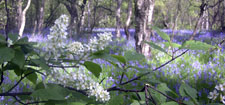Biodiversity
Biodiversity means the biological diversity of life. It includes a wide range of living things from flowering plants to mammals, birds, insects and bacteria. It includes common species, those that are under threat, and the habitats that humans, plants and animals depend on. The character and biodiversity of the landscape are closely linked. Many of the features that contribute most to our appreciation of the landscape – trees and hedges, ancient woodlands, the flowers of old meadows, pastures and heaths – are an essential part of its biodiversity.
Biodiversity in Decline
The biodiversity of the English landscape as a whole has been in decline for many decades. Development and changing land management practices have led to the widespread loss of landscape features and wildlife habitats. This has left many important habitats much reduced in their extent and fragmented or isolated. The rate of habitat loss has slowed in recent years due to the improved protection of important sites, the introduction of agri-environmental schemes and the conservation work of public and voluntary sector bodies. Despite this the legacy of fragmentation and isolation poses a threat to the survival of some species, a problem made more acute by the pressures of climate change, and many formerly common species continue to decline.
Conserving and Restoring Biodiversity
Conserving and restoring biodiversity requires a combination of statutory protection for nationally important sites and species, the protection of both non-statutory sites and biodiversity in general from the impacts of development, the positive management of existing sites and habitats for wildlife, and the restoration of habitat quality and connectivity at a landscape scale.
The county’s most important sites have statutory protection as Sites of Special Scientific Interest (SSSI). Some of these are also designated as National Nature Reserves or as Special Areas for Conservation or Special Protection Areas under European legislation. The county also contains a large number of non-statutory Local Wildlife Sites (formerly known as County Wildlife Sites). Policies for the protection of these sites are contained in local plans and emerging local development frameworks. The Durham Wildlife Trust owns or manages a number of nature reserves in the county and there are several Local Nature Reserves managed by local authorities. The Durham Biodiversity Action Plan (DBAP) builds on the UK National Biodiversity Action Plan and contains action plans for a wide range of species and habitats, delivered through the Durham Biodiversity Action Plan Partnership.
A Landscape-scale Approach
While the protection and management of important sites and species is an essential task, it is also important to improve the quality of habitats in the wider landscape. This needs to involve both enlarging and linking important habitats that are fragmented or isolated, restoring those which are damaged or degraded, and improving the quality of the surrounding environment to sustain the wildlife outside Existing initiatives including agri-environmental schemes like Environmental Stewardship and grants like the England Woodland Grant Scheme (WGS) will have an important role to play in this process. If they are to be effective they need to be part of a landscape scale approach to biodiversity, one that is integrated with wider social, economic and environmental objectives, and one that involves a wide range of partners. Further work is needed to identify needs and opportunities for habitat creation and restoration work across the county to ensure that the spatial issues affecting biodiversity are better understood.
Integrating Action on Biodiversity and Landscape
The objectives and strategies proposed in the County Durham Landscape Strategy have been strongly influenced by biodiversity issues and particularly by the DBAP and by Natural England’s Natural Area Profiles. Natural Areas are closely related to Countryside Character Areas and together they provide a common structure for dealing with landscape and biodiversity issues. The potential of new landscape-scale partnerships based on Natural Areas is currently (2008) being investigated in the region.
Biodiversity, Design and Development
New development can have both positive and negative effects on biodiversity. If it is to be truly sustainable the net effect must be positive and much can be achieved through careful site selection and design and the adoption of appropriate mitigation measures. Building in Sustainability, a guide to sustainable development and construction in the north-east, gives guidance on biodiversity and development. Landscaping proposals that form part of new development can contribute to biodiversity by establishing new habitats of wildlife value, and particularly through the use of locally native species, and by establishing appropriate plant communities and management regimes.
Objectives
- To support and encourage the conservation and enhancement of biodiversity and the delivery of the Durham Biodiversity Action Plan.
- To promote and develop a landscape-scale approach to biodiversity in County Durham.
- To promote an integrated approach to action on landscape and biodiversity, and particularly through the use of Natural Area Partnerships.
- To secure a ‘positive audit’ for biodiversity in new development.
- To promote biodiversity in landscape design.



